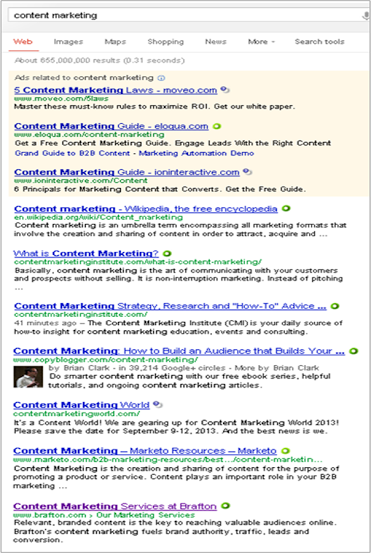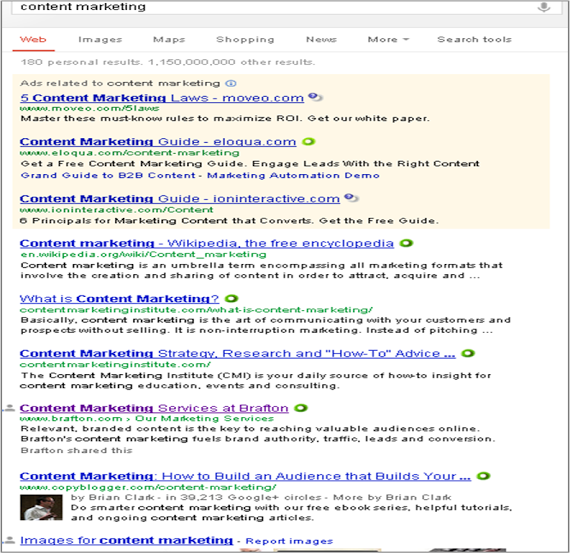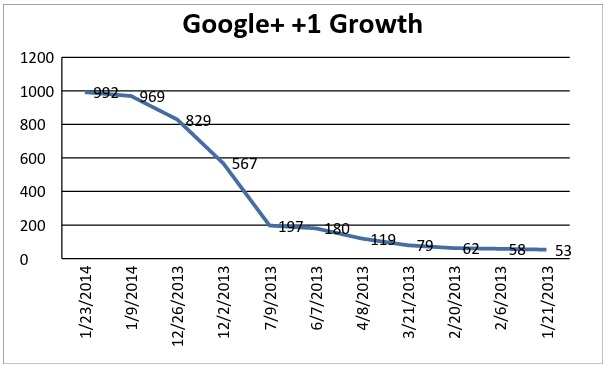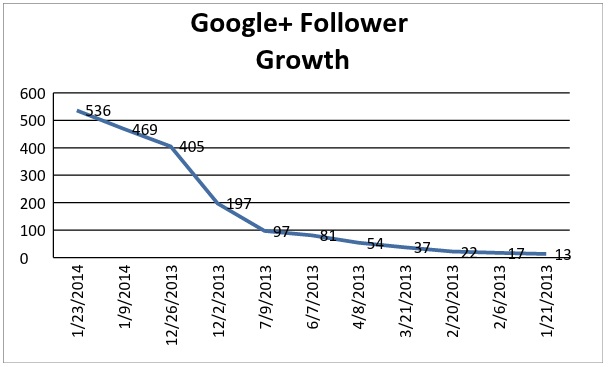Google+ marketing is one of the best opportunities your brand is missing. I manage dozens of social media marketing campaigns – across networks and across verticals – and countless marketers are game to try new Twitter interactions, or maybe a Facebook contest, but they still see Google+ as a network where crickets chirp. Do you think you’re not going to gain as much traction and engagement on Google+ as you do on Twitter or Facebook? Here’s why I think you should reconsider if you’re looking for social ROI.
Social SEO… just the tip of the iceberg
First, let’s address the SEO value that Google+ offers (even though it offers so much more).
To be clear, Google DOES NOT SAY that Google+ popularity influences search rankings. But let’s take a look at two searches. These are snapshots of SERPs for content marketing. One was provided by a non-Brafton employee who is not connected with Brafton on Google+, and the other was provided by a non-Brafton employee who is connected with Brafton on Google+ (and was logged into her gmail at the time of the search).
Our brand is clearly more prominent in search results for someone who has the Brafton Company Page in a circle. You can read more about the impact of building up a Google+ presence in some of our industry coverage.
A lot of businesses that make the decision to try Google+ marketing start because they want more search exposure. It’s what gets them on board, but Google+ has many more advantages.
Welcome to G+ Community marketing
When Google+ first emerged on the scene, brands could only add updates to company Pages.
Now we have Communities to work with, and they’re an integral part of every strategy I put together for customers, and we’ve seen great results. I recently wrote a blog on the top social trends to watch out for in 2014 and Google+ communities were at the top of the list.
For the uninitiated, Google+ Communities are opt-in forums where like-minded Google+ users talk about specific topics. Think of them as discussion forums within Google+, or this network’s equivalent of LinkedIn Groups. Users and businesses can join Communities or start their own.
This best way to demonstrate Communities’ value is with an example that gives great insight as to why communities are not only important to foster thought leadership, but also to increase your overall social engagement.
A G+ Community success story
One client in the energy industry handed us they keys to its social media strategy in January of 2013. At that time, their company’s Google+Page had about 52+1’s, and 12 profiles had the brand in their circles (so they had 12 followers). We started the strategy with Page status updates, interactions with relevant professionals and re-sharing the company’s Brafton-produced content. Although we realized interactions might be limited due to the fact that the network was new and still coming into its own, we felt it was important to establish a presence. That way, when the network did pick up, our client would be ahead of the game!
Around the time we started this strategy, Google+ announced Communities. We instantly knew that’s where we were headed, but we felt it would be beneficial to build up a presence on the Page first. By gaining some traction and initial interactions, we’d have a pool of (at least semi-) engaged users to tap for Communities.
After six months of Page updates and interactions, we witnessed substantial growth. The campaign increased the clients’ +1’s to 180 (+246 percent) and followers grew to 81 (+575 percent). These were some great stats, but we didn’t want to get complacent with our strategy and knew there was still an untapped market in Communities.
We put together a revised strategy to begin posting and interacting within relevant Google+ Communities. The plan was to participate in discussions and post conversation-relevant content multiple times per week into different Communities, with the hopes of reaching wider audiences and driving more traffic back to the site.
Conversations and sharing build relevant connections
Over the first six months on G+, we saw a slow, but steady, increase in followers. But once we started participating in Communities, we added 536 followers in six months’ time (compared to 68 added followers in the previous reporting period). Communities proved great for interaction – there were actual conversations taking place with followers – and these were all relevant because they’d opted into industry-focused groups. Plus, the reach and the number of new people reading, commenting on and sharing this content gave our client an added layer of exposure. The company’s +1’s increased 403 percent over six months, suggesting we were connecting with users who actually read and cared about the brand’s messages.
Communities proved great for interaction – there were actual conversations taking place with followers – and these were all relevant because they’d opted into industry-focused groups.
Google+ Communities drive convertible traffic
If the staggering increase in engagement didn’t convince you of the benefits of Google+ Communities, then maybe the influx in traffic that our client saw will be persuasive. Throughout the first half of the year (no Communities), fewer than 50 site visits came from Google+. This might be why companies think there’s no one on the site.
Don’t overlook G+ for social marketing
Once we built up the strategy, there was a 292 percent increase in Google+ referral traffic. Even more important? The majority of this traffic engaged longer and crawled deeper on the site than other visitors. The client also saw a 350 percent increase in new visits from it’s pre-G+ days after we increased the volume of posts going to community groups.
Overall, I hoped that this was educational and you now understand the importance of having true active social profiles. Creating, adding graphics and making the occasional status update to your social network is only the start to having a successful online marketing campaign. To really begin to gain traction and see results, it is imperative to engage with industry leaders and social profiles who are related to your target market. In the end, this will benefit your brand in increasing brand awareness, reach and ultimately help drive quality traffic back to your site.





